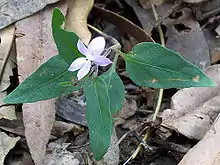Pseuderanthemum variabile
Pseuderanthemum variabile is a species of plant in the family Acanthaceae. Its natural habitat is the floor of rainforest or wet eucalyptus forest of northern and eastern Australia, north of Bega, New South Wales. Common names include night and afternoon, pastel flower and love flower.[1]
| Pseuderanthemum variabile | |
|---|---|
 | |
| Pseuderanthemum variabile flowering in a Blackbutt forest at Chatswood West, Australia | |
| Scientific classification | |
| Kingdom: | Plantae |
| Clade: | Tracheophytes |
| Clade: | Angiosperms |
| Clade: | Eudicots |
| Clade: | Asterids |
| Order: | Lamiales |
| Family: | Acanthaceae |
| Genus: | Pseuderanthemum |
| Species: | P. variabile |
| Binomial name | |
| Pseuderanthemum variabile | |
Description
It is a ground cover, up to 30 cm high, with hairy stems.
Leaves are from 2 to 7 cm long and up to 4 cm wide, lanceolate to ovate in shape. Sometimes a hard mineral deposit occurs on the leaves. The base of the leaf can be purple and dotted with glands.
The violet-sized flowers appear between November and May, and can be white, lilac, purple or blue, often with spots near the middle. Occasionally the flowers do not open and are self fertilising. The fruit is a capsule, sometimes hairy.
Uses
In the garden, it makes an attractive ground cover for shady areas. It is the food plant for caterpillars of a number of butterflies in the family Nymphalidae, including Doleschallia bisaltide, Hypolimnas alimena, Hypolimnas bolina, Hypolimnas misippus and Junonia orithya.[2]
References